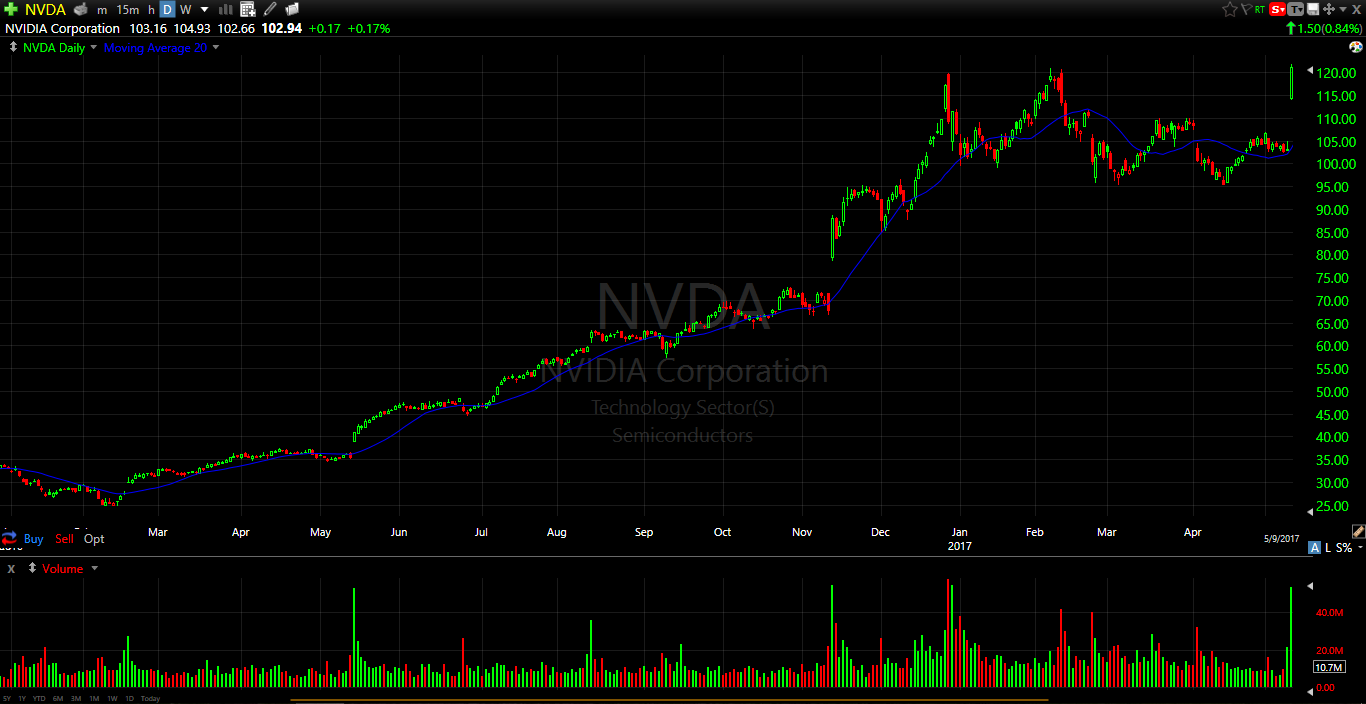Momentum stocks will often have follow through momentum in the following days after a big breakout/ breakdown with the right catalyst. However, you don’t want to blindly buy and short an in play stock from the previous day. Here are 3 steps you should use to evaluate the probability of a stock having follow through momentum to determine if there is still money to be made:
- Analyze the daily chart of the stock
- Be aware of the sector, float and catalyst of the Stock
- Pay Attention to the Intraday Trend
1. Analyze the Daily Chart of the Stock
The daily chart of a stock will tell you a lot about a stock’s potential to have follow through. You want to see what happened in prior years when the stock gapped up or down with a catalyst. Did the stock have a multi day run after breaking out or breaking down? Did it just sell off after gapping up and then retraced to where it came from? Has the stock been consolidating for weeks/months before a breakout? How has the stock behaved in prior months when it has gapped up or down with a certain catalyst (earnings is usually the one)? What is the overall trend of the daily chart in the past year?
Let’s say we’re looking at NVDA the morning of 5/11 before the market opened after it had an earnings beat with a nice day 1 move. Here is what the daily would look like that morning:
This is a picture perfect daily setup for a day 2 continuation. It has a strong daily uptrend, it has a history of following through after an earnings breakout, it just broke 52 week highs, it has been consolidating for 4 months under the 120 level after a few tests, and it had above average volume the day prior.
2. Be Aware of the Sector, Float, and Catalyst
These three fundamental factors play a big part in the potential of a stock having follow through momentum. Certain sectors are much more likely to have stocks that have day 2 continuation then others. If the stock has a low float and a strong catalyst in a hot sector, the probability increases even more. Low float stocks tend to make bigger moves because they have fewer shares in supply so high demand for shares will push the price higher in a short period of time. You also have to be aware of catalysts and how they affect stocks. Earnings catalysts (positive or negative earnings) are the best catalysts for follow through the next day. No matter what the catalyst is, you should always go back to the daily chart and see how the stock behaved in the past reacting to a similar catalyst. If it’s a different catalyst besides earnings that only happens once in awhile (like successful Phase 3 drug results), you want to look at other stocks in the sector that have had a similar catalyst and see how they reacted to the same news.
If we look at ZGNX this week, we see that it had a big day 1 move with successful drug trial results as the catalyst combined with a daily breakout. Although it had a huge gap (of around 100%), it still followed through. In pretty much any other sector besides Biotech, there is very low probability of follow through after such a huge gap up (even with an earnings catalyst). However biotech stocks this year have had a history of following through after breaking out with the same catalyst. If we look at INSM and CLVS from this summer, they had huge gap ups on successful drug trial results. Both of these stocks sold off at the open, and then they rebounded and followed through for days afterwards. This is almost exactly what ZGNX did on the first day, and this is why we played this to the longside the day after for continuation for some nice profits.
Here is a video describing the trade in ZGNX:
3. Pay Attention to the Intraday Trend
After examining a momentum stocks’ daily chart and fundamentals, it is time to look at the more micro picture. Even if everything else is lined up, if the stock does not give a safe intraday buy signal you don’t want to take that trade. You want to pay attention to how the stock closed yesterday and where it is opening today. If you’re looking for continuation to the long side, you don’t want to see the stock gapping up another 20% the next day (ideally the stock gaps down a bit if you’re looking for a continuation long). You also want to see the stock close strong on the previous day. If it closes weak, it decreases the probability of continuation to the long side (vice versa for continuation to the short side).
ZGNX had a nice daily breakout, a strong catalyst, and was in a hot sector with a recent history of stocks in the same sector following through for days on the same catalyst. It closed very strong on day 1, had a small gap up, and gave a nice flag to safely enter on after the market opened.
If you’re not sure of the setups and price patterns that we’re talking about you can learn them all in our Bulls Bootcamp. It’s an intensive 60 day course to teach you exactly how I trade and why. To learn more or signup, email me at kunal@bullsonwallstreet.com today!



